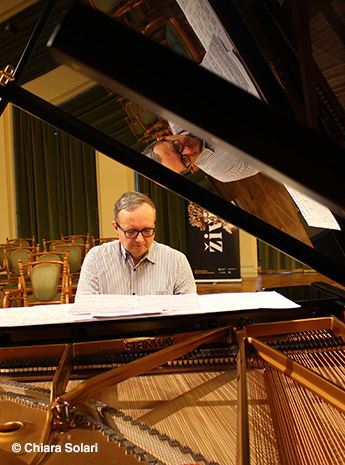
About this Release
“During Vittorio Rieti's long and prolific life, he was at the centre of many of the musical developments of his time. A friend of Stravinsky, Poulenc and Schönberg, he also found his own musical idiom, which in many senses was rooted in his native Italian language. His style can only be described as unique, pleasant, melodious and fascinating. He was invited by Diaghilev to write two ballets for "Les Ballets Russes", and later on, while residing in the USA, he continued to pursue an extraordinary career between New York, Rome and Paris. In this first instalment, some of his finest works for solo piano and two pianos are gathered together. It is a unique and special opportunity to be part of his fascinating creative universe, a discovery that is long overdue.” — Giorgio Koukl
RIETI, VITTORIO (1898–1994)
Complete Piano Solo & Duo Works • 1
- Giorgio Koukl, piano
- Virginia Rossetti, piano
‘My music may not be performed often, but it is performed all over the world’, wrote the Italian-American composer Vittorio Rieti. His orchestral works were conducted and admired by luminaries such as Rafael KubelÃk, Leopold Stokowski and Arturo Toscanini but it was the piano that was arguably Rieti’s first and most significant musical love to which he brought a natural, effortless and brilliant style. The Second Avenue Waltzes for two pianos, one of his greatest works, is an expression of his maturity and full of charm, whereas the later Twelve Preludes for solo piano reveal a wealth of inventiveness. One of his most successful pieces, the Suite champêtre for two pianos, is fuelled by grace and elegance. Giorgio Koukl has been called ‘one of the five or six greatest living pianists today’ by The Art Music Lounge; he is joined in the works for piano duo by the prize-winning pianist Virginia Rossetti.
Tracklist
|
Suite champêtre (1948) (00:13:13 )
|
|
1
I. Bourrée (00:06:02)
|
|
2
II. Aria et Écossaise (00:05:18)
|
|
3
III. Gigue (00:03:10)
|
|
3 Vaudeville Marches (1969) (00:06:00 )
|
|
4
No. 1. Tempo di marcia (00:01:46)
|
|
5
No. 2. — (00:02:03)
|
|
6
No. 3. — (00:02:22)
|
|
Second Avenue Waltzes (1942) (00:11:12 )
|
|
7
No. 1. À Yo (00:01:42)
|
|
8
No. 2. À Mar (00:02:06)
|
|
9
No. 3. À Elsie (00:02:49)
|
|
10
No. 4. À Fabio (00:02:19)
|
|
11
No. 5. À John (00:02:52)
|
|
12
No. 6. À Phyllis (00:04:48)
|
|
13
Gossip (1979) (00:01:43)
|
|
14
Valse Fugitive (1970) (00:01:44)
|
|
12 Preludes (1979) (00:20:00 )
|
|
15
No. 1. Moderato cantabile (00:02:15)
|
|
16
No. 2. Allegro (00:00:57)
|
|
17
No. 3. Moderatamente mosso (00:02:00)
|
|
18
No. 4. Allegretto (00:00:43)
|
|
19
No. 5. Andante cantabile, "La Bella addormentata" (Sleeping Beauty) (00:01:22)
|
|
20
No. 6. Andante espressivo e sostenuto (00:01:00)
|
|
21
No. 7. Allegretto alla marcia (00:01:51)
|
|
22
No. 8. Scorrevole (00:01:46)
|
|
23
No. 9. Moderato (00:02:27)
|
|
24
No. 10. Allegretto scherzando (00:01:47)
|
|
25
No. 11. Allegro (00:01:16)
|
|
26
No. 12. Passacaglia: Andante moderato (00:02:14)
|
|
6 Pezzi Brevi (6 Short Pieces) (1932) (00:10:00 )
|
|
27
No. 1. Preludio (00:01:41)
|
|
28
No. 2. Invenzione (00:01:34)
|
|
29
No. 3. Elegia (00:01:46)
|
|
30
No. 4. Momento musicale (00:01:04)
|
|
31
No. 5. Barcarola (00:02:25)
|
|
32
No. 6. Saltarello (00:01:40)
|
|
5 Pieces for Young Pianists (1942) (00:06:00 )
|
|
33
No. 1. Prelude (00:00:44)
|
|
34
No. 2. Canon (00:01:00)
|
|
35
No. 3. Valsette (00:01:10)
|
|
36
No. 4. Tarantella (00:01:28)
|
|
37
No. 5. Silly Polka (00:01:23)
|
The Artist(s)
 Giorgio Koukl is a Czech pianist/harpsichordist and composer. He studied at both the Conservatories of Zürich and Milan, where he took part in the masterclasses of Nikita Magaloff, Jacques Février, and Stanislaus Neuhaus, and with Rudolf Firkušný, friend and advocate of Czech composer Bohuslav Martinů. It was through Firkušný that Koukl first encountered Martinů‘s music, and is now considered one of the world’s leading interpreters of Martinů‘s piano music. As a logical continuation of this work, Koukl has recorded the complete solo piano works of Paul Le Flem, Alexander Tcherepnin, Arthur Lourié, Vítězslava Kaprálová, Witold Lutosławski, and more recently, Alexandre Tansman and Tibor Harsányi.
Giorgio Koukl is a Czech pianist/harpsichordist and composer. He studied at both the Conservatories of Zürich and Milan, where he took part in the masterclasses of Nikita Magaloff, Jacques Février, and Stanislaus Neuhaus, and with Rudolf Firkušný, friend and advocate of Czech composer Bohuslav Martinů. It was through Firkušný that Koukl first encountered Martinů‘s music, and is now considered one of the world’s leading interpreters of Martinů‘s piano music. As a logical continuation of this work, Koukl has recorded the complete solo piano works of Paul Le Flem, Alexander Tcherepnin, Arthur Lourié, Vítězslava Kaprálová, Witold Lutosławski, and more recently, Alexandre Tansman and Tibor Harsányi.  Virginia Rossetti began her piano studies with Massimiliano Ferrati, later attending the ‘Antonio Buzzolla’ Conservatory in Adria where she graduated with honours. She has a Master of Performing Arts with distinction at the Hochschule für Musik in Basel and a Master in Pedagogy at the Conservatorio della Svizzera italiana. Rossetti is a prize winner of several national and international piano competitions including the Premio Venezia 2009, reserved for the best graduates under the patronage of the Republic’s President, and the Premio Marizza in Trieste.
Virginia Rossetti began her piano studies with Massimiliano Ferrati, later attending the ‘Antonio Buzzolla’ Conservatory in Adria where she graduated with honours. She has a Master of Performing Arts with distinction at the Hochschule für Musik in Basel and a Master in Pedagogy at the Conservatorio della Svizzera italiana. Rossetti is a prize winner of several national and international piano competitions including the Premio Venezia 2009, reserved for the best graduates under the patronage of the Republic’s President, and the Premio Marizza in Trieste. The Composer(s)
 ‘My music may not be performed often, but it is performed all over the world’, wrote the Italian-American composer Vittorio Rieti (1898–1994). His orchestral works were conducted and admired by luminaries such as Rafael Kubelík, Leopold Stokowski and Arturo Toscanini but it was the piano that was arguably Rieti’s first and most significant musical love to which he brought a natural, effortless and brilliant style. The Second Avenue Waltzes for two pianos, one of his greatest works, is an expression of his maturity and full of charm, whereas the later Twelve Preludes for solo piano reveal a wealth of inventiveness. One of his most successful pieces, the Suite champêtre for two pianos, is fuelled by grace and elegance. Giorgio Koukl has been called ‘one of the five or six greatest living pianists today’ by The Art Music Lounge; he is joined in the works for piano duo by the prize-winning pianist Virginia Rossetti.
‘My music may not be performed often, but it is performed all over the world’, wrote the Italian-American composer Vittorio Rieti (1898–1994). His orchestral works were conducted and admired by luminaries such as Rafael Kubelík, Leopold Stokowski and Arturo Toscanini but it was the piano that was arguably Rieti’s first and most significant musical love to which he brought a natural, effortless and brilliant style. The Second Avenue Waltzes for two pianos, one of his greatest works, is an expression of his maturity and full of charm, whereas the later Twelve Preludes for solo piano reveal a wealth of inventiveness. One of his most successful pieces, the Suite champêtre for two pianos, is fuelled by grace and elegance. Giorgio Koukl has been called ‘one of the five or six greatest living pianists today’ by The Art Music Lounge; he is joined in the works for piano duo by the prize-winning pianist Virginia Rossetti. Reviews
“Throughout, Giorgio Koukl and Virginia Rossetti adopt a bright, percussive touch that serves Rieti’s muse well, and are cleanly recorded. …Koukl and Rossetti give the work plenty of zing. This is a worthwhile tribute to a composer who…does not deserve to have his music ignored.” – Fanfare

“The pianists give flawless performances, deft and with a light touch, to showcase these superb compositions. I look forward to more music of this outstanding composer. I am pleased to have been introduced to him.” – MusicWeb International



 Grand Piano has gained a reputation for producing high quality recordings of rare keyboard gems. Dedicated to the exploration of undiscovered piano repertoire, the label specialises in complete cycles of piano works by many lesser-known composers, whose output might otherwise have remained unknown and unrecorded.
Grand Piano has gained a reputation for producing high quality recordings of rare keyboard gems. Dedicated to the exploration of undiscovered piano repertoire, the label specialises in complete cycles of piano works by many lesser-known composers, whose output might otherwise have remained unknown and unrecorded.






